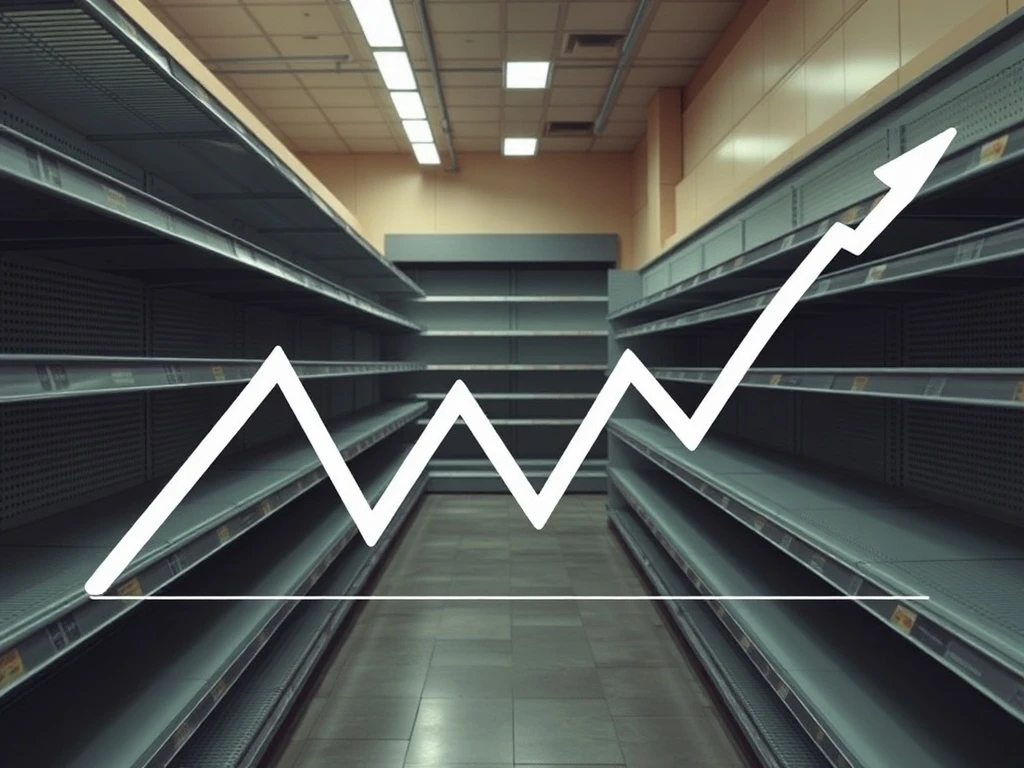The financial world often sees significant shifts. Recently, a major development sent ripples through the food industry. A prominent grocery store supplier filed for Chapter 11 bankruptcy protection. This move signals considerable challenges within the sector. It also raises questions about future food availability and pricing. This grocery supplier bankruptcy could reshape how many people shop for essentials.
Understanding the Sudden Grocery Supplier Bankruptcy
News of a large grocery supplier bankruptcy recently surfaced. This development caught many industry observers by surprise. The supplier, a key player in the food distribution network, cited severe financial pressures. These pressures include escalating operational costs and persistent supply chain disruptions. Furthermore, high inflation rates impacted their profitability. This situation highlights the fragile nature of modern supply chains. It also underscores the economic challenges facing businesses today.
- Escalating Costs: Fuel prices, labor wages, and raw material costs increased significantly.
- Supply Chain Disruptions: Global events and logistical hurdles created inefficiencies.
- Inflationary Pressures: Rising prices for goods did not always translate to higher profit margins.
The company aims to reorganize its debts under Chapter 11. This legal process allows businesses to continue operations. It also provides a framework for financial restructuring. The goal is to emerge stronger and more sustainable. However, the immediate effects of this grocery supplier bankruptcy are already being felt.
Immediate Repercussions for Grocery Stores
The grocery supplier bankruptcy directly impacts numerous retail chains. Many grocery stores relied heavily on this supplier. They sourced a wide array of products from its extensive network. Consequently, these stores now face immediate challenges. They must quickly find alternative suppliers. This search can be complex and time-consuming. It may also lead to temporary product shortages.
For instance, stores might experience gaps on their shelves. Popular items could become unavailable. This situation creates inconvenience for consumers. It also puts pressure on store managers. They must manage inventory levels carefully. Moreover, establishing new supply relationships takes time. New contracts need negotiation. Logistics systems require adjustments.
- Supply Chain Disruption: Retailers scramble to secure alternative sources.
- Product Shortages: Consumers may notice empty shelves for certain goods.
- Logistical Challenges: New delivery routes and schedules must be established.
Furthermore, the cost of goods could rise. New suppliers might charge higher prices. These increased costs may be passed on to consumers. Therefore, shoppers might see price increases on their favorite products. The overall stability of the food supply chain is paramount. This bankruptcy highlights its vulnerability.
Consumer Impact and Potential Price Hikes from Grocery Supplier Bankruptcy
Consumers often feel the direct effects of major industry shifts. This grocery supplier bankruptcy is no exception. Shoppers may encounter changes at their local supermarkets. The most noticeable effect could be a reduction in product variety. Stores might prioritize essential items. Less common or specialty products could disappear. This reduction limits consumer choice.
Additionally, price increases are a significant concern. When a major supplier exits, demand shifts to remaining providers. This increased demand can empower remaining suppliers to raise prices. Consequently, grocery bills could climb for households. Families are already managing rising living costs. Any further price hikes add to their financial burden.
Consider the potential ripple effect. A supplier’s bankruptcy impacts farmers and producers too. They lose a major distribution channel. This can lead to surplus inventory for some producers. Others might face payment delays. Ultimately, these issues can affect the entire food ecosystem. Consumers, therefore, bear some of the indirect costs.
- Reduced Product Variety: Fewer options on shelves.
- Increased Grocery Bills: Potential price hikes due to new supplier costs.
- Supply Chain Instability: Broader effects on producers and the market.
This situation also creates uncertainty. Shoppers may worry about the consistency of their food supply. Such concerns can influence buying habits. Some consumers might start stocking up on staples. This behavior can further strain existing supply chains. Thus, the grocery supplier bankruptcy has far-reaching implications beyond just the company itself.
Navigating Chapter 11: A Path to Reorganization
Chapter 11 bankruptcy provides a specific legal framework. It allows a company to reorganize its business. The primary goal is to return to profitability. During this process, the company continues to operate. It also works with creditors to manage its debts. This differs significantly from Chapter 7 bankruptcy. Chapter 7 typically involves liquidation.
For this particular grocery supplier bankruptcy, the company will present a reorganization plan. This plan outlines how it will repay its debts. It also details how it will restructure operations. A bankruptcy court must approve this plan. Creditors also have a say in the process. This legal protection allows the company breathing room. It can stabilize its finances without immediate pressure from lawsuits.
The process is often complex and lengthy. It involves extensive negotiations. The company might sell off non-essential assets. It could also renegotiate contracts with suppliers and customers. The aim is to shed unprofitable ventures. It also seeks to streamline core operations. Success hinges on a viable business strategy. It also depends on creditor cooperation.
- Operational Continuity: The company keeps running.
- Debt Restructuring: A plan is developed to manage outstanding obligations.
- Court Oversight: The process occurs under judicial supervision.
Furthermore, the company’s management remains in control. They operate as “debtor in possession.” This means they manage the company’s assets. They do so for the benefit of creditors. This setup encourages a more efficient restructuring. It allows experienced leadership to guide the recovery. The ultimate outcome of this grocery supplier bankruptcy remains uncertain. However, the Chapter 11 filing offers a structured path forward.
Broader Economic Implications and Industry Trends
The grocery supplier bankruptcy is not an isolated event. It reflects broader economic pressures. The food industry faces unique challenges. These include volatile commodity prices. Geopolitical events also disrupt global trade. Furthermore, labor shortages impact processing and distribution. These factors create a difficult operating environment.
Many businesses are grappling with high inflation. Consumers have less disposable income. This shift affects purchasing power. Companies, therefore, struggle to pass on rising costs. They fear losing customers. This creates a squeeze on profit margins. The bankruptcy of a major supplier signals this pressure. It suggests that even large players are vulnerable.
The industry may see further consolidation. Smaller suppliers could struggle more. Larger companies might acquire distressed assets. This trend could lead to fewer, bigger players. While potentially more efficient, it also reduces competition. Less competition can sometimes lead to higher prices for consumers.
- Inflationary Pressures: Companies absorb costs to retain customers.
- Supply Chain Fragility: Global events highlight vulnerabilities.
- Market Consolidation: Larger entities may acquire struggling businesses.
Moreover, investment in resilient supply chains becomes crucial. Companies are rethinking their strategies. They are diversifying suppliers. They are also exploring local sourcing options. This proactive approach aims to prevent future disruptions. The long-term effects of this grocery supplier bankruptcy could reshape industry practices. Businesses are learning valuable lessons from this challenging period.
The incident underscores the critical importance of robust supply chain management. Companies globally are re-evaluating their logistics. They are investing in technology to track goods. They are also building stronger relationships with multiple partners. This focus on resilience aims to prevent future shocks. It is a long-term strategic shift. Businesses recognize that single points of failure are too risky. The grocery supplier bankruptcy serves as a stark reminder of this necessity.
Retailers’ Strategies to Mitigate Impact
Grocery retailers are not passively observing this situation. They are actively implementing strategies. Their goal is to minimize the impact of the grocery supplier bankruptcy. Diversifying their supplier base is a primary tactic. Many stores work with multiple distributors. This reduces reliance on any single entity. It provides a safety net during disruptions.
Furthermore, some retailers are strengthening direct relationships. They are connecting directly with farmers and producers. This approach bypasses traditional distributors. It offers greater control over sourcing. It can also reduce costs. However, it requires significant logistical capabilities. Not all retailers can adopt this model easily.
- Supplier Diversification: Spreading risk across multiple partners.
- Direct Sourcing: Building relationships directly with producers.
- Inventory Management: Optimizing stock levels to prevent shortages.
Another strategy involves enhancing inventory management systems. Retailers use data analytics. They forecast demand more accurately. This helps them stock appropriate levels of goods. It reduces waste. It also ensures popular items remain available. This proactive approach is vital. It helps maintain customer satisfaction.
Finally, communication with customers is key. Stores are transparent about potential issues. They explain any temporary shortages. They also highlight alternative products. This open dialogue builds trust. It manages customer expectations effectively. The retail sector continues to adapt. It navigates a complex and evolving economic landscape.
The Path Ahead: What to Expect Post-Bankruptcy Filing
The Chapter 11 filing marks a significant turning point. However, it is not the end for the company. The grocery supplier bankruptcy process is designed for rehabilitation. Over the coming months, several key developments will unfold. The company will work on its reorganization plan. This plan must satisfy its creditors. It must also demonstrate a viable path to profitability.
Legal proceedings will continue. Court hearings will address various aspects of the bankruptcy. Creditors will file claims. The company will negotiate with them. The goal is to reach agreements on debt repayment. This phase requires considerable legal and financial expertise. It is a meticulous and detailed process.
The market will also adjust. Other suppliers may expand their operations. They could absorb some of the demand. This might create new opportunities for growth. Conversely, some smaller suppliers might face increased competition. The landscape of food distribution is likely to shift. This shift could have lasting effects.
- Reorganization Plan: The company develops a strategy for financial recovery.
- Creditor Negotiations: Discussions to settle outstanding debts.
- Market Adjustments: Other suppliers adapt to the new competitive environment.
Ultimately, the success of the grocery supplier bankruptcy reorganization depends on many factors. These include economic conditions. They also include the company’s ability to innovate. Its management team’s leadership is also crucial. The food industry will closely watch these developments. Its stability relies on the health of its key players.
The implications of this bankruptcy extend beyond the immediate financial realm. It will likely spur innovation in logistics. New technologies might emerge to enhance tracking. Furthermore, alternative distribution models could gain traction. For example, local food hubs might become more prevalent. This would reduce reliance on large, centralized systems. The industry is constantly evolving. This challenge may accelerate necessary adaptations. The outcome of this grocery supplier bankruptcy will inform future business strategies across the sector.
The filing of a major grocery supplier bankruptcy underscores significant pressures. It highlights the vulnerabilities within the food supply chain. This event impacts not only the company itself. It also affects grocery stores, consumers, and the broader economy. While Chapter 11 offers a chance for recovery, the path is challenging.
The coming months will reveal the full extent of this situation. Retailers are adapting. Consumers are adjusting. The industry is learning valuable lessons. This development emphasizes the need for resilience. It also stresses the importance of diverse and robust supply networks. The goal remains a stable and affordable food supply for everyone.
Frequently Asked Questions (FAQs)
Q1: What does Chapter 11 bankruptcy mean for a company?
A1: Chapter 11 bankruptcy allows a company to reorganize its business. It continues operations while developing a plan. This plan addresses its debts and aims for future profitability. It provides legal protection from creditors during this restructuring period.
Q2: How will this grocery supplier bankruptcy affect my local grocery store?
A2: Your local grocery store may experience temporary product shortages. They might also adjust their pricing. This happens as they seek new suppliers. Stores are working to find alternative sources for goods.
Q3: Will food prices increase because of this bankruptcy?
A3: There is a potential for food prices to increase. When a major supplier exits, remaining suppliers may raise their prices. This can lead to higher costs for retailers. These costs might then be passed on to consumers.
Q4: Is this a sign of broader problems in the food industry?
A4: Yes, this grocery supplier bankruptcy reflects broader economic challenges. These include high inflation, rising operational costs, and supply chain disruptions. Many businesses in the food sector are currently facing similar pressures.
Q5: How long does a Chapter 11 reorganization typically take?
A5: The duration of a Chapter 11 reorganization varies. It can range from several months to a few years. The complexity of the company’s debts influences the timeline. Creditor negotiations and court approvals also play a role.
Q6: What measures are grocery retailers taking to prevent shortages?
A6: Grocery retailers are diversifying their supplier networks. They are also exploring direct sourcing from producers. Furthermore, they are improving inventory management. These steps aim to ensure a consistent supply of products.
























